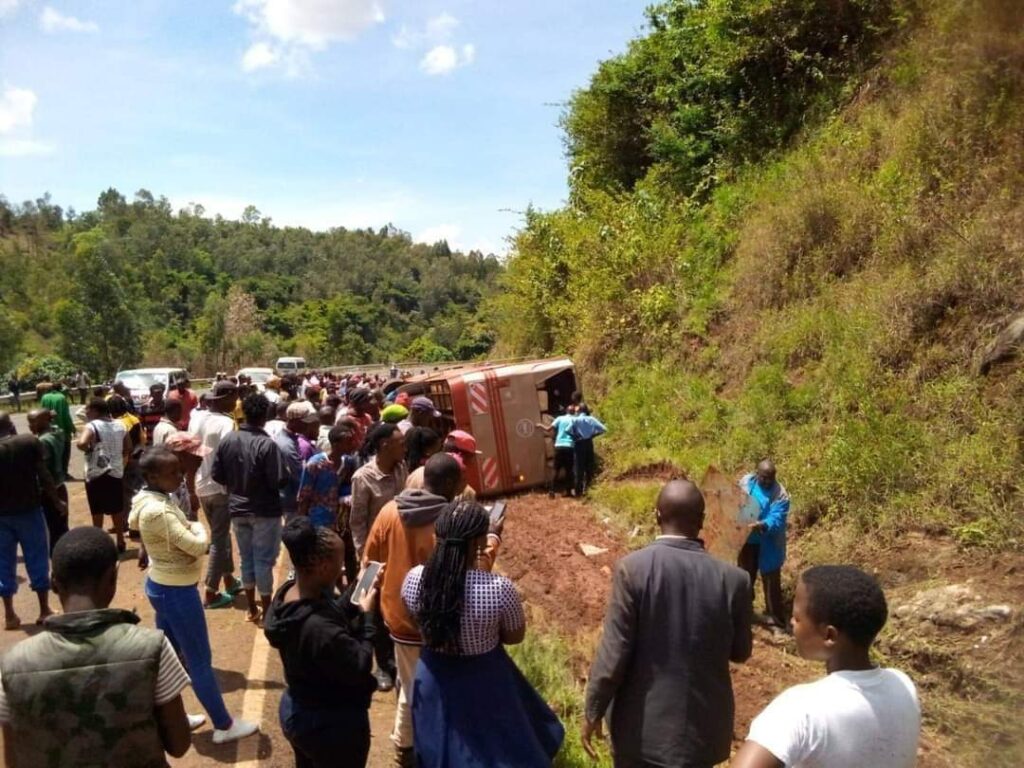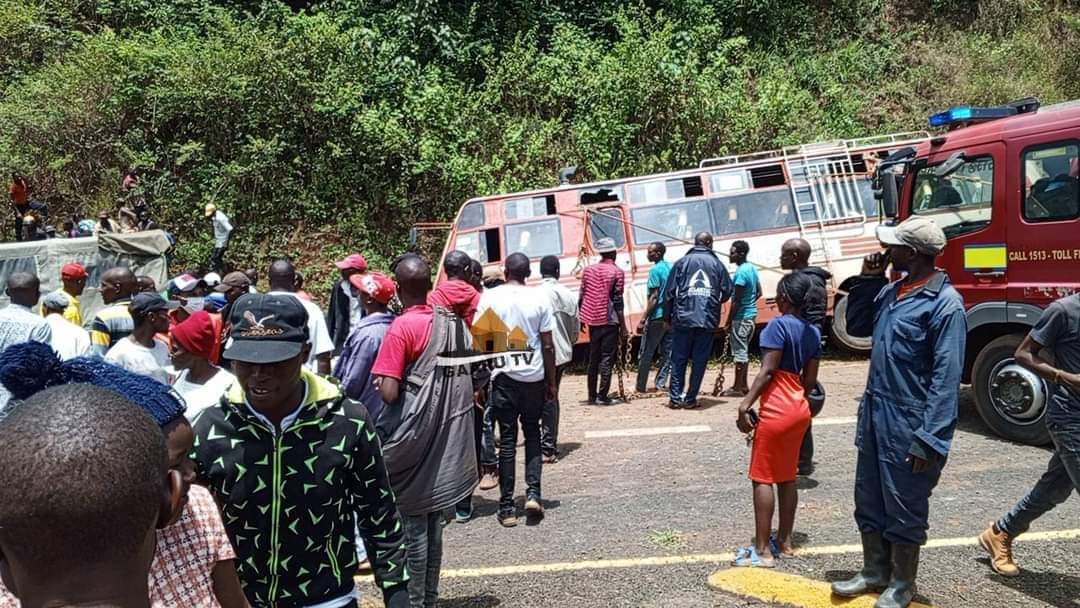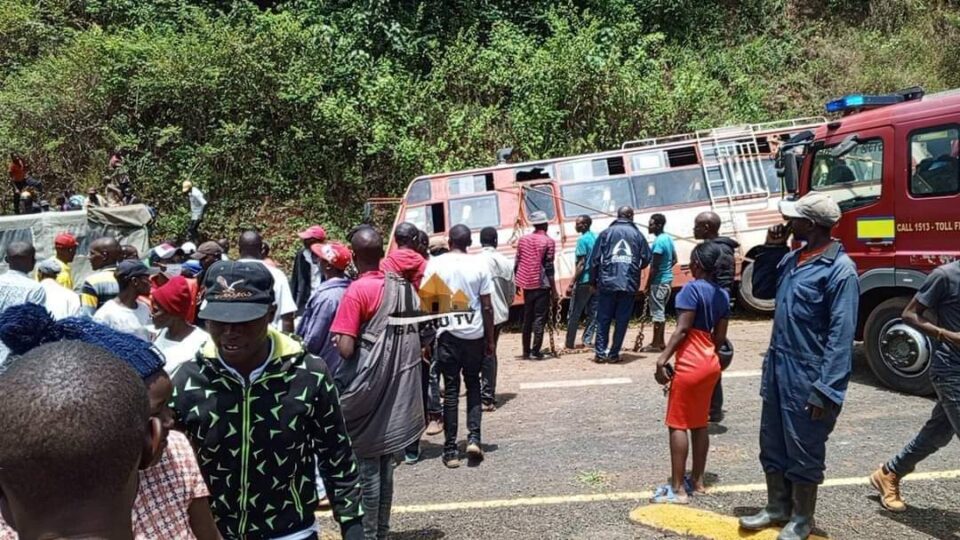Tharaka Nithi county police commander Zacchaeus Ngeno has confirmed an accident where several passengers are feared dead and scores injured.The accident involved a bus travelling from Meru to Nairobi at the Tharaka Nithi bridge on Sunday noon.Ngeno said the cause of the accident remains unknown as officers embark on a probe into the fatal accident.


We are still conducting a probe to establish the number of fatalities but we are certain that we had some fatalities,” Ngeno said.Several feared dead, scores injured after bus rolls at Nithi bridgePolice say the cause of the accident is yet to be establishedTharaka Nithi county police commander Zacchaeus Ngeno has confirmed an accident where several passengers are feared dead and scores injured.
The accident involved a bus travelling from Meru to Nairobi at the Tharaka Nithi bridge on Sunday noon.Ngeno said the cause of the accident remains unknown as officers embark on a probe into the fatal accident.”We are still conducting a probe to establish the number of fatalities but we are certain that we had some fatalities,” Ngeno said.
Some of the affected passengers were taken to hospitals nearby for medical attention.The county police boss urged drivers to be more vigilant and ensure their cars are in good shape to avoid accidents.However, a witness claimed he had seen at least three people who had died. There are fears the numbers may go up. By press time, rescue operations were still underway with medics spotted at the scene.
The tranquility of a Sunday afternoon journey turned into chaos and devastation as a bus traveling from Meru to Nairobi met with a tragic accident at the Tharaka Nithi Bridge. Reports indicate that several lives were lost, and scores were injured, sending shockwaves through communities and highlighting the persistent challenges of road safety in Kenya.
Contextualizing Road Safety Challenges in Kenya:
Kenya’s road safety record has been marred by numerous challenges, including poor infrastructure, inadequate enforcement of traffic regulations, reckless driving, and vehicle overloading. These factors contribute to a high rate of road accidents, claiming thousands of lives annually and leaving many more injured or disabled.
Tharaka Nithi Bridge: A Critical Link:
The Tharaka Nithi Bridge serves as a vital link between the counties of Tharaka Nithi and Meru, facilitating the movement of people and goods between these regions and connecting them to Nairobi, the capital city. Its significance in the transportation network makes any accident at this location particularly impactful, disrupting travel and causing widespread repercussions.
Bus Travel: Convenience vs. Safety:
Buses are a common mode of transportation in Kenya, offering convenience and affordability for many commuters. However, the safety standards of some buses often fall short, with issues such as overloading, poor maintenance, and driver fatigue posing significant risks to passengers and other road users.
The Meru to Nairobi Route:
The route from Meru to Nairobi spans approximately 270 kilometers, traversing diverse terrain and road conditions. While this journey offers scenic views of Kenya’s landscapes, it also presents challenges such as winding roads, steep inclines, and variable weather conditions, demanding careful driving and adherence to safety protocols.
Road Conditions: The condition of the road leading to the bridge, including surface quality, signage, and visibility, could have played a role in the accident. Poorly maintained roads increase the risk of accidents, especially during adverse weather conditions.
Driver Error: Human error, including speeding, reckless driving, and fatigue, remains a leading cause of road accidents in Kenya. Drivers may succumb to pressure to meet tight schedules or fail to adhere to traffic regulations, putting passengers’ lives at risk.
Vehicle Overloading: Overloading is a common practice among public transport operators in Kenya, driven by economic considerations and the desire to maximize profits. However, exceeding a vehicle’s capacity compromises its stability and maneuverability, increasing the likelihood of accidents, particularly on challenging terrain.
Mechanical Failure: Inadequate maintenance and mechanical defects in the bus could have contributed to the accident. Brake failures, tire blowouts, and other mechanical issues pose significant hazards, especially when combined with other risk factors.
Response and Rescue Efforts:
Following the accident, emergency response teams, including paramedics, firefighters, and law enforcement personnel, rushed to the scene to provide assistance and coordinate rescue operations. The injured were transported to nearby hospitals for urgent medical treatment, while the process of identifying and recovering the deceased commenced amidst the wreckage.
Community Impact and Mourning:
The aftermath of the accident reverberated throughout the affected communities, eliciting expressions of shock, grief, and solidarity. Families anxiously awaited news of their loved ones, while local authorities and community leaders mobilized support networks to provide comfort and assistance to those affected by the tragedy.
Investigation and Accountability:
In the wake of the accident, authorities launched investigations to determine the circumstances and causes of the tragedy. This process involves examining various factors, including the condition of the road, the actions of the driver, the state of the bus, and compliance with safety regulations. Holding accountable those responsible for negligence or misconduct is crucial for preventing similar incidents in the future and ensuring justice for the victims and their families.
Addressing Road Safety Challenges:
The Nithi Bridge bus accident underscores the urgent need for comprehensive measures to enhance road safety in Kenya:
Infrastructure Investment: Improving road infrastructure, including maintenance, expansion, and safety enhancements, is essential for reducing accidents and minimizing their impact on communities and the economy.
Regulatory Enforcement: Strengthening enforcement of traffic laws and regulations, including penalties for violations such as speeding, overloading, and reckless driving, can deter risky behavior and promote safer road practices.
Public Awareness and Education: Raising awareness about road safety issues and promoting responsible behavior among road users through campaigns, education programs, and community engagement initiatives can help cultivate a culture of safety and mutual respect on the roads.
Industry Accountability: Holding public transport operators accountable for adhering to safety standards, maintaining their vehicles properly, and prioritizing passenger safety over profit margins is essential for improving the overall safety of bus travel in Kenya.
The Nithi Bridge bus accident serves as a tragic reminder of the persistent challenges facing Kenya’s road safety efforts. As the nation mourns the loss of lives and supports those affected by the tragedy, concerted action is needed to address the underlying factors contributing to road accidents and ensure that such incidents are prevented in the future. By investing in infrastructure, enforcing regulations, raising public awareness, and promoting accountability, Kenya can strive towards a safer and more secure transportation network for all its citizens.

